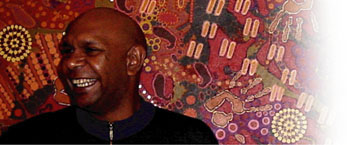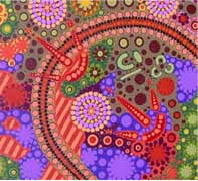
|
Jukurrpa (Creation). |
Visit his website at www.walangari.com.au or contact Walangari
| Aboriginal Culture |
| Masterwork |
| The Meaning of Kartawarra |
| Painting is in the family. |
| Iconography |
Walangari Karntawarra, (b. 1961 - ) is an exciting, sophisticated contemporary artist from Central Australia. He is an accomplished teacher whose artworks convey his dream for us, often utilising the traditional stories that he has inherited by birth.
Walangari, like the majority of artists, enjoys self-made success. He philosophises on the unofficial 5 - 8 year apprenticeship that most artists have to undergo and recounts his transformation from teacher to artist with the story telling finesse of a world weary traveller. Karntawarra's work tells about his life, family and hopes for humanity by drawing on the traditional stories and Dreamings he inherited by birth. He re-tells them in this ancient form of written language through unique and contemporary interpretation. As he writes,
"Aboriginal culture is one of abstraction, a collection of colourful concepts related to the rainbow. Through the rainbow snakes (our creators) we were able to achieve the sublime, and unified all cultural beliefs like the way the rainbow harmonises colours." - Karntawarra, Artist Statement (11 September 2000)
Karntawarra's largest work to date is his latest masterwork, Jukurrpa (Creation - featured at the top of this article.), painted when he was Artist in Residence at the Museum of Sydney during the Bamaradbanga, the "Unhinged: Yuendumu Doors" exhibition. It took him 22 days to complete and is 2.1m squared.
It is about family, where every circle represents a person. The repeating patterns of circles within circles tell two stories about people. Firstly, they show the interrelationships between different clans at home and secondly, it tells of how all people are related, especially in light of the aboriginal view on reincarnation where we come from and return to the stars. In this worldview everything is sacred, everything is family.
This story of interrelatedness is Walangari's story. It is his to tell in the same way that the Milky Way is his to paint, as it is one of his Dreamings, inherited by birth. Spirits re-enter the earth as falling stars and might be any part of a world embraced by a Universe that is held to be female because she is giving birth all the time. Everything must be protected and the dreaming stories teach us and celebrate how to do this, both physically and spiritually.
 |
| Milkyway Dreaming |
Jukurrpa contains such a story. It illustrates a non-racist humanity where everyone is connected. The message that often motivates Karntawarra's work is that, "Racism only exists in those who create it." His paintings echo the understanding that we are in fact the same as everything else.
Another layer of this picture is a story that tells about a time in Australia when there was a 10 000 year drought. During this time the aboriginal people of Australia journeyed all over the world while certain warriors stayed behind to protect the sacred sites.
Karntawarra found evidence of association with other cultures in a stolen Egyptian Temple at the Egypt Museum in Berlin. He was looking at the main sarcophagus with Yanawirri Yiparrka (Ian Forrest) when they saw a figure depicted blowing a yidarki (digeridoo). They simultaneously thought of going off to look for something and went off in separate directions. They then entered the same room from different directions and, gesticulating loudly, they saw a Western boomerang at the same time. It was a very significant "classical" boomerang, the type that can be used to make fire. Karntawarra wishes he had been there when it was handed over to the Egyptians.
Karntawarra could see further evidence in that the men were depicted as wearing red ochre while the women wore yellow. These colours are very significant to the Central Desert creation story. In the tradition of Thor Heyerdahl, these Aboriginal people travelling in Europe thought this was more than a coincidence.
In the ancient story about aboriginal contact with other cultures, Karntawarra tells of how the aboriginal kinship system was adopted by the South Western Mediterranean cultures. Aboriginal men and women would wait for particular star patterns to emerge before they went off into the desert for a "honey-moon", to procreate. The baby would then be born nine months later under a particular astrological sign associated with its skin group. In this way the constellation and alignment of the start patterns determined which skin group their child was born into. The story holds that the visitors took this kinship system all over the world and others employed it in their own cultures.
That some of Karntawarra's icons are contemporary in form is nothing new. Aboriginal icons have been evolving with interpretations throughout history. For example, he could easily read the story written in symbols on tomb walls taken from Middle Eastern cultures. For example the U shaped icon depicting a sitting figure (the shape we leave in the sand) had been squared and stylised by other ancient cultures.
 |
| Winparrku |
Winparrku is a sacred site of even more significance than Uluru. It is a conical shaped peak where the two creators came out of the ground. They poked their heads out all over the world, but Winparrku is where the two snakes emerged in a transparent form (, like baby snakes are transparent when they hatch). The male creator then became red and transformed into a man called Yarrapirri while the female creator became yellow and changed into a woman named Karntawarra. All of her descendants carry her name and use her colour, yellow ochre, in their ceremonies.
Walangari Kartawarra writes about his painting of Winparrku:
"This painting depicts my country which is about 275 km west of Alice Springs, in the Central Desert Region of Central Australia. The colours reflect the landscape and scenery as well as the abundance of bush foods and medicines."
Walangari himself emerged from a period of painting in traditional colours in May last year. He had been painting in his own style in earth colours for only a couple of years. He felt that he had to, until he perfected it. His paintings then started getting "too earthy" - so he exploded back into colours in May 1999.
His new major work - Jukurrpa (Creation) - is the language of his mob and incorporates the contemporary design of a wheel with three spokes. Karntawarra sees this wheel as a way of putting Dreamtime into motion. The wheel of course is only activated by thinking about it, where it changes our thoughts to reflect the harmony amongst all people. As a consequence of thinking about the story of interrelatedness that the picture tells, our actions change. We slowly become cured of our fears and xenophobias.
 |  |
 |  |
| Centipede | Children | Emu | Warrior |
The iconography present in Walangari's work is a traditional form of written language. Walangari's symbols encapsulate the old and the new. For example the hands on the canvas correlate to elders, the left hand representing females and the right hand, males. They are not only painted onto the canvas but come from within it, they go in and out, like man and woman, similar to a yin and yang kind of balance. The hands are a traditional icon that Karntawarra has represented in a contemporary way. Another icon painted with this interesting amalgam of techniques is the children's feet. Although painted in a contemporary way, they are painted in the same way that Karntawarra learnt how to track. He explains it by making gestures of printing a track in the sand. The feet were painted in the same manner.
Some of the icons Walangari incorporates into his work are:
 |  |
| Emu Dreaming | Honey Ant Dreaming |
Walangari started painting 13 years ago in 1987. He started painting out of boredom and poverty as a student at the Northern Territory University in Darwin. But the primary reason that he started painting was to recreate his family about him. Today he sees his paintings as babies - pieces that are adopted out.
The subject matter of his works are often one of the many Dreamings he inherited by birth. There are an extraordinary number - indicative of the seniority of his family. Karntawarra talks about his great grandfather (his mother's father's father) as someone who knew not only 12 languages but everything - he was entitled to know everything.
Walangari's Dreamings that tradition permits him to paint include: centipede, water, rainbow, caterpillar, fire, witchetty grub, euro (hill kangaroo), the milky way, emu, snake, kangaroo mouse, honey ant and the 7 sisters (the Pliades Constellation).
Walangari's career as a painter is definitely inspired by his family. With such ancestors as Albert Namatjira and the great living artist Clifford Possum to inspire him we wonder why he took up the brush so late.
Other ancestors were leaders in their field. Charlie Hong was the first baker in Alice Springs and Sydney Walker, a Camelier from Afghanistan, was sort after by the Australian colonial power of the time. He taught people like Bourke and Wills the craft of handling camels.
Karntawarra recently exhibited in the windows of the Galeries Lafeyette in Paris during September and in both the Chairman's lounge and the QANTAS club at the Sydney Airport. He also danced, performed and taught at the Papunya Tula exhibition in October 2000 at the AGNSW.
Photography and page design © Jayne Waterford 2000